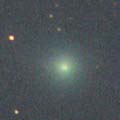
|
It will pass only 0.17 A.U. from the sun in mid January, and reach to 1 mag. It had been visible visually in the evening low sky until mid November. But it is not observable now. However, Michael Jager and Gerald Rhemann succeeded to catch it using their CCD camera on Dec. 26. On the same day, Piotr Guzik could catch it visually. The comet was about 4.5 mag, brightening better than expected. When the comet reaches to 1 mag, it is not observable on the earth, but it will be visible in the SOHO/LASCO images. Maybe a wide field photo can catch the comet in the twilight. In the Southern Hemisphere, it appears at 3.5-4 mag in late January, then it keeps observable while fading gradually. In the Northern Hemisphere, it will never be observable again.
Date(TT) R.A. (2000) Decl. Delta r Elong. m1 Best Time(A, h)
Dec. 23 18 10.76 -9 15.0 1.611 0.701 14 5.8 18:23 ( 85, -9)
Dec. 30 18 33.23 -8 5.2 1.397 0.516 15 4.8 5:36 (273, -9)
|

|
When it approached to the earth between from November to early December, it reached up to 8.5 mag as a very large diffuse object with a diameter larger than 10 arcmin (Nov. 23, Peter Bus). It kept 9 mag and observable in excellent condition for a long time since mid October until mid December. However, now it is fading, down to 10.8 mag (Dec. 23, Yoshimi Nagai). It will fade out rapidly after January. It will be fainter than 14 mag, too faint to see visually, in February. It will set down in the evening sky at 17 mag in March.
Date(TT) R.A. (2000) Decl. Delta r Elong. m1 Best Time(A, h)
Dec. 23 4 1.89 51 59.2 0.844 1.734 143 9.8 21:48 (180, 73)
Dec. 30 2 51.49 48 43.0 0.992 1.787 129 10.5 20:13 (180, 77)
|
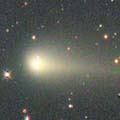
|
It reached up to 9.3 mag between October and November (Oct. 27, Juan Jose Gonzalez). It had been observable in excellent condition. But it is fading now. It has already faded down to 10.7 mag (Dec. 23, Seiichi Yoshida). However, it keeps observable after this until May when it fades down to 16 mag. It will be visible visually for a long time until around March.
Date(TT) R.A. (2000) Decl. Delta r Elong. m1 Best Time(A, h)
Dec. 23 2 35.41 2 41.2 0.938 1.709 125 10.4 20:28 ( 0, 58)
Dec. 30 2 44.03 3 20.1 1.001 1.726 120 10.6 20:09 ( 0, 58)
|

|
After it kept 5.5-6.0 mag from early October to mid October, it suddenly brightened in outburst on Oct. 24, and reached up to 4.2 mag on Oct. 25 (Maik Meyer). It became easily visible with naked eyes, and a very long tail of 5 degrees was visible with binoculars. But now it is fading, and it has already faded down to 10.4 mag (Dec. 24, Mike Linnolt). It will be 11.5 mag in early January, then it will be too low to observe soon.
Date(TT) R.A. (2000) Decl. Delta r Elong. m1 Best Time(A, h)
Dec. 23 20 44.09 -1 36.8 2.249 1.694 44 10.5 18:23 ( 68, 26)
Dec. 30 20 56.73 -3 1.8 2.432 1.790 39 10.9 18:27 ( 70, 21)
|

|
It was too low in the evening to observe in October and November. But it is getting higher in the morning sky again. Now it is 12.2 mag (Dec. 28, Juan Jose Gonzalez). It keeps 12-13 mag until March and visible visually for a long time.
Date(TT) R.A. (2000) Decl. Delta r Elong. m1 Best Time(A, h)
Dec. 23 16 44.18 24 10.8 2.496 2.033 51 12.6 5:34 (257, 24)
Dec. 30 16 58.10 27 24.0 2.437 2.052 55 12.6 5:36 (255, 29)
|

|
In this season, it has been bright as 12-13 mag and visible visually since it appeared in the morning sky in early July. Now it is 13.1 mag (Dec. 22, Seiichi Yoshida). Diffuse, and not easy to see visually. However, it looks very large on CCD images, with a diameter of about 2 arcmin. It keeps observable in good condition until March.
Date(TT) R.A. (2000) Decl. Delta r Elong. m1 Best Time(A, h)
Dec. 23 3 50.19 30 26.4 4.997 5.866 149 13.3 21:42 ( 0, 85)
Dec. 30 3 47.65 30 9.1 5.060 5.868 142 13.3 21:12 ( 0, 85)
|

|
It had been unobservble for a long time. When it appeared again in the morning sky, it has showed a cometary activity and it has become much brighter than expected. It was visible visually on Oct. 31 at 13.7 mag (Seiichi Yoshida). It is bright as 13.6 mag still now (Dec. 17, Ken-ichi Kadota). It keeps 13-14 mag until March. It is observable in good condition in the Southern Hemisphere. However, it will not be observable in the Northern Hemisphere soon.
Date(TT) R.A. (2000) Decl. Delta r Elong. m1 Best Time(A, h)
Dec. 23 12 52.14 -40 23.8 2.185 2.001 66 13.6 5:34 (346, 13)
Dec. 30 13 7.95 -43 54.4 2.153 2.011 68 13.6 5:36 (349, 10)
|

|
Now it is 14.6 mag (Dec. 23, Seiichi Yoshida). Almost asteroidal. It did not brighten at all since early September. Although the slight cometary activity was detected in late July, it became completely stellar soon. Its tail became visible again in late October, however, now it is stellar. In the Northern Hemisphere, it keeps good condition after this. It keeps locating high until spring. If it keeps asteroidal after this, it will be 14 mag at best. It may suddenly become active and brighten rapidly someday. But actually, it is getting a bit fainter than this ephemeris recently.
Date(TT) R.A. (2000) Decl. Delta r Elong. m1 Best Time(A, h)
Dec. 23 22 4.52 41 16.3 0.831 1.235 85 13.9 18:23 (114, 61)
Dec. 30 22 33.72 43 19.8 0.804 1.227 86 13.8 18:27 (118, 61)
|

|
First return of a new bright periodic comet observed at 9 mag in 2001. But it has not been recovered yet. The condition of this apparition is bad. It keeps locating very low in the evening. But it is expected to reach up to 11 mag in February and March. However, it was not detected on Dec. 27, fainter than 16.5 mag (Filip Fratev). So, it seems to be much fainter than this ephemeris in fact.
Date(TT) R.A. (2000) Decl. Delta r Elong. m1 Best Time(A, h)
Dec. 23 20 8.70 -11 37.1 2.028 1.301 31 14.9 18:23 ( 66, 13)
Dec. 30 20 31.02 -10 53.7 1.985 1.239 30 14.3 18:27 ( 68, 12)
|

|
It has been visible at 13.5 mag for a long time since 2005 autumn until 2006 spring. Now it is fainter than last year by 1 mag, however, it is still visible visually at 14.2 mag (Dec. 22, Seiichi Yoshida). It keeps observable in excellent condition until April.
Date(TT) R.A. (2000) Decl. Delta r Elong. m1 Best Time(A, h)
Dec. 23 13 3.92 22 4.9 5.518 5.537 85 14.4 5:34 (299, 67)
Dec. 30 13 7.02 22 3.8 5.439 5.555 91 14.4 5:36 (312, 72)
|

|
It was still visible visually at 14.2 mag on Oct. 31 (Seiichi Yoshida). However, it has already faded down to 15.8 mag (Dec. 15, Ernesto Guido and Giovanni Sostero). It is fainter than this ephemeris by 1 mag recently. It keeps a good contition until spring, while the comet will be fading gradually.
Date(TT) R.A. (2000) Decl. Delta r Elong. m1 Best Time(A, h)
Dec. 23 10 4.12 24 36.1 3.334 3.988 125 15.0 3:59 ( 0, 80)
Dec. 30 10 1.16 24 54.2 3.318 4.055 133 15.1 3:29 ( 0, 80)
|

|
It is observable in good condition in the Southern Hemisphere. But it is not observable until January in the Northern Hemisphere. It was discovered at 17.5 mag in May. Then it has not been brightening well. It is 16.5-17 mag still in December. It will be observable also in the Northern Hemisphere in the evening low sky from January to March, however, it will be fainter than 15 mag.
Date(TT) R.A. (2000) Decl. Delta r Elong. m1 Best Time(A, h)
Dec. 23 3 23.61 -57 28.9 2.418 2.648 92 15.1 21:14 ( 0, -2)
Dec. 30 3 5.14 -53 33.9 2.418 2.625 90 15.1 20:29 ( 0, 2)
|

|
Now it is 15.5 mag (Dec. 3, Ken-ichi Kadota). It is observable at 15.5-16 mag until spring. But, in the Northern Hemisphere, it locates somewhat low at 20-30 degree high.
Date(TT) R.A. (2000) Decl. Delta r Elong. m1 Best Time(A, h)
Dec. 23 7 3.83 -34 1.4 3.343 3.938 120 15.6 1:00 ( 0, 21)
Dec. 30 6 47.00 -34 37.8 3.317 3.929 122 15.5 0:16 ( 0, 20)
|
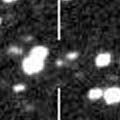
|
It tends to become brightest about 4 months after the perihelion passage. In this apparition, it was 17.6 mag in late July around the perihelion passage (July 23, Filip Fratev), however, it brightened up to 14.1 mag and became visible visually on Dec. 23 (Seiichi Yoshida). But it will start fading after this. Although it keeps a good condition for a long time, it will be fainter than 18 mag in March.
Date(TT) R.A. (2000) Decl. Delta r Elong. m1 Best Time(A, h)
Dec. 23 5 36.62 17 43.0 1.218 2.196 171 15.6 23:28 ( 0, 73)
Dec. 30 5 31.08 18 15.9 1.264 2.227 164 15.8 22:55 ( 0, 73)
|
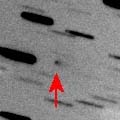
|
It was expected to reach to 13 mag in winter. But actually, it was 15.7 mag at best (Dec. 5, Ken-ichi Kadota), much fainter than expected. It will fade out rapidly after this. It will be fainter than 18 mag in February.
Date(TT) R.A. (2000) Decl. Delta r Elong. m1 Best Time(A, h)
Dec. 23 8 19.05 43 3.7 0.726 1.637 145 15.7 2:15 (180, 82)
Dec. 30 8 18.52 47 52.6 0.735 1.652 147 15.8 1:47 (180, 77)
|

|
Recovered after 15 year blank. The condition is good in this return. It was expected to reach to 13.5 mag in November. But actually, it was 15.0 mag at best (Dec. 2, Ken-ichi Kadota), fainter than expected. It was reported as 12 mag visually in mid November, but it seems to be confused by nearby faint galaxies. How it is fading rapidly. It has already faded down to 16.5 mag (Dec. 21, Mt. Lemmon Survey).
Date(TT) R.A. (2000) Decl. Delta r Elong. m1 Best Time(A, h)
Dec. 23 23 10.56 -4 16.3 0.946 1.189 76 15.9 18:23 ( 29, 47)
Dec. 30 23 36.32 1 3.3 0.981 1.222 76 16.4 18:27 ( 35, 51)
|
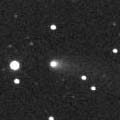
|
It was bright as 13.2 mag on Sept. 27, and visible visually (Seiichi Yoshida). But it has already faded down to 15.4 mag (Dec. 2, Ken-ichi Kadota). It is already too faint to see visually. It will be getting lower in the evening sky, and will be unobservable at the end of January.
Date(TT) R.A. (2000) Decl. Delta r Elong. m1 Best Time(A, h)
Dec. 23 22 43.85 -16 5.1 3.788 3.500 65 16.4 18:23 ( 31, 33)
Dec. 30 22 50.64 -15 9.8 3.894 3.514 60 16.5 18:27 ( 38, 31)
|
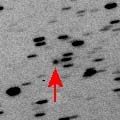
|
Now it is 16.6 mag (Dec. 2, Ken-ichi Kadota). A bit fainter than this ephemeris, but it became almost as bright as expected. Although it kept 16 mag for a while, it will start fading after this, and will be fainter than 18 mag in February.
Date(TT) R.A. (2000) Decl. Delta r Elong. m1 Best Time(A, h)
Dec. 23 10 55.61 -12 36.5 1.423 1.867 100 16.5 4:50 ( 0, 42)
Dec. 30 10 58.85 -14 46.5 1.392 1.903 105 16.6 4:26 ( 0, 40)
|

|
It was observed on Dec. 22 as 17.0 mag (S. Bruzzone, S. Roland), as bright as expected. The condition in this return is bad. It is only observable in the evening low sky before the perihelion passage. It is best to observe in December when it becomes 17 mag and locates at 20 degree high. It will be getting lower gradually after January. It will be 16 mag in February, but will be lower than 10 degree high.
Date(TT) R.A. (2000) Decl. Delta r Elong. m1 Best Time(A, h)
Dec. 23 22 10.32 -26 45.7 2.240 1.865 55 17.1 18:23 ( 33, 20)
Dec. 30 22 24.87 -24 31.0 2.258 1.828 52 16.9 18:27 ( 38, 20)
|
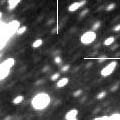
|
Now it is 17.4 mag (Dec. 3, Ken-ichi Kadota). It keeps 17 mag for a long time after this until the end of 2007. It will be getting lower in the evening sky after this, and will be unobservable. However, It will be observable in good condition again in 2007 autumn.
Date(TT) R.A. (2000) Decl. Delta r Elong. m1 Best Time(A, h)
Dec. 23 21 12.51 33 1.0 3.765 3.588 72 16.9 18:23 (102, 49)
Dec. 30 21 24.71 32 36.1 3.814 3.580 68 16.9 18:27 (103, 45)
|

|
Now it is 16.5 mag (Dec. 2, Ken-ichi Kadota). It is outside of Jupiter's orbit. So it keeps 17 mag for a long time until 2007 summer. It keeps locating high and observable in good condition for a long time after this because it moves in the northern sky.
Date(TT) R.A. (2000) Decl. Delta r Elong. m1 Best Time(A, h)
Dec. 23 14 41.85 37 29.4 7.255 7.103 77 17.1 5:34 (252, 53)
Dec. 30 14 44.47 37 30.7 7.197 7.116 81 17.1 5:36 (254, 59)
|

|
It reached up to 16 mag in 2005 summer in the Southern Hemisphere. Now it is 17.2 mag (Dec. 4, Ken-ichi Kadota). The brightening was very slow, and the fading seems also very slow. It will keep 17 mag until January after this. But then it will turn to fade out rapidly, and will be fainter than 18 mag in February.
Date(TT) R.A. (2000) Decl. Delta r Elong. m1 Best Time(A, h)
Dec. 23 5 7.55 -20 14.6 4.383 5.117 134 17.1 22:59 ( 0, 35)
Dec. 30 5 3.03 -19 15.1 4.446 5.156 131 17.2 22:27 ( 0, 36)
|
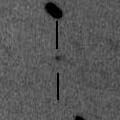
|
Now it is 17.0 mag (Dec. 17, Ken-ichi Kadota). The perihelion passage is in 2008. It will be observable for several years after this at around 17 mag. But it may fade out rapidly just after the perihelion passage.
Date(TT) R.A. (2000) Decl. Delta r Elong. m1 Best Time(A, h)
Dec. 23 4 22.27 11 2.7 3.816 4.712 152 17.1 22:14 ( 0, 66)
Dec. 30 4 18.98 11 16.0 3.857 4.700 145 17.2 21:43 ( 0, 66)
|

|
It reached to 16 mag in early 2006. Now it is 17.3 mag (Dec. 2, Ken-ichi Kadota). It will be fading very slowly from 17 mag to 18 mag until 2007 summer. In the Northern Hemisphere, it keeps locating high.
Date(TT) R.A. (2000) Decl. Delta r Elong. m1 Best Time(A, h)
Dec. 23 14 6.09 30 40.6 5.638 5.528 78 17.2 5:34 (268, 59)
Dec. 30 14 10.40 30 43.2 5.581 5.551 83 17.2 5:36 (271, 64)
|

|
It keeps 17 mag until January. Then it keeps observable util April when it becomes fainter than 18 mag.
Date(TT) R.A. (2000) Decl. Delta r Elong. m1 Best Time(A, h)
Dec. 23 4 7.33 51 56.2 2.992 3.830 143 17.2 21:59 (180, 73)
Dec. 30 4 3.09 51 31.7 3.026 3.827 139 17.2 21:28 (180, 73)
|

|
It is observable in excellent condition at 17.5 mag in December and January. It will be fainer than 18 mag in March.
Date(TT) R.A. (2000) Decl. Delta r Elong. m1 Best Time(A, h)
Dec. 23 6 35.12 29 6.8 1.356 2.333 171 17.3 0:31 ( 0, 84)
Dec. 30 6 29.13 29 12.2 1.349 2.330 173 17.3 23:53 ( 0, 84)
|

|
It will be brightening gradually at the high altitude until 2007 spring, while it brightens up to 16 mag. Then it keeps 15.5-16 mag for one year and a half until 2008 summer. However, because the comet moves southwards, it is only observable until 2007 June in the Northern Hemisphere.
Date(TT) R.A. (2000) Decl. Delta r Elong. m1 Best Time(A, h)
Dec. 23 11 11.78 6 47.1 3.939 4.294 104 17.5 5:07 ( 0, 62)
Dec. 30 11 12.54 6 12.1 3.786 4.244 111 17.4 4:40 ( 0, 61)
|

|
It was visible visually at 12 mag in last spring. Now it is 16.8 mag (Dec. 21, Katsumi Yoshimoto), brighter than this ephemeris. It will keep good condition for a while after this, but it will be fading gradually.
Date(TT) R.A. (2000) Decl. Delta r Elong. m1 Best Time(A, h)
Dec. 23 16 30.11 30 14.5 4.551 4.119 58 17.5 5:34 (252, 30)
Dec. 30 16 34.82 31 21.0 4.561 4.184 61 17.5 5:36 (254, 35)
|

|
Peculiar asteroid moving along an orbit like a comet. It was observable in excellent condition at opposition in October, then it reached to 16.5 mag. Now it is fading, and will be fainter than 18 mag in January.
Date(TT) R.A. (2000) Decl. Delta r Elong. m1 Best Time(A, h)
Dec. 23 1 14.23 -6 15.6 1.664 2.120 103 17.6 19:07 ( 0, 49)
Dec. 30 1 21.56 -5 27.5 1.722 2.105 98 17.7 18:47 ( 0, 50)
|

|
Although it moves very far away from the earth, now it is brightest around the perihelion. It keeps observable in good condition at 18 mag until February.
Date(TT) R.A. (2000) Decl. Delta r Elong. m1 Best Time(A, h)
Dec. 23 5 32.22 18 56.3 2.636 3.612 171 17.7 23:24 ( 0, 74)
Dec. 30 5 27.48 18 40.6 2.659 3.613 163 17.7 22:52 ( 0, 74)
|

|
It kept 16.5 mag for a year and a half since early 2005. It will start fading after November, and will be fainter than 18 mag at the end of 2006.
Date(TT) R.A. (2000) Decl. Delta r Elong. m1 Best Time(A, h)
Dec. 23 23 40.31 16 53.2 4.133 4.272 91 17.7 18:23 ( 35, 69)
Dec. 30 23 43.60 15 39.7 4.290 4.314 84 17.8 18:27 ( 47, 64)
|
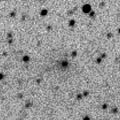
|
Now it is around the aphelion and faintest, but it is observed at 18 mag. It will be observable at 18 mag in good condition until March. It will be 13-14 mag and visible visually again in 2009. It will reach to 12.5 mag in 2010. But in the Northern Hemisphere, it will locate very low in the south at that time.
Date(TT) R.A. (2000) Decl. Delta r Elong. m1 Best Time(A, h)
Dec. 23 6 2.92 28 27.4 3.740 4.721 174 17.8 23:54 ( 0, 83)
Dec. 30 5 57.57 28 33.8 3.747 4.718 170 17.8 23:22 ( 0, 84)
|
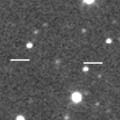
|
It was unexpectedly bright as 17 mag on Oct. 16 (Michael Jager and Gerald Rhemann). But it will be fainter than 18 mag soon.
Date(TT) R.A. (2000) Decl. Delta r Elong. m1 Best Time(A, h)
Dec. 23 2 18.34 29 40.7 1.697 2.445 129 17.8 20:11 ( 0, 85)
Dec. 30 2 20.42 29 39.1 1.773 2.455 123 17.9 19:46 ( 0, 85)
|
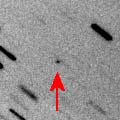
|
Although it was so faint as 20.7 mag on Aug. 2 (P. Birtwhistle), it brightened rapidly as expected, and reached up to 15.7 mag on Nov. 15 (Ken-ichi Kadota). Now it should be already fading. But actually, it is 16.1 mag still on Dec. 19 (Ken-ichi Kadota), much brighter than this ephemeris. Although it has already passed the perihelion, it seems not to have started fading yet. In the Northern Hemisphere, it keeps a good condition for a long time after this. It will be observable at 16-17 mag for a while.
Date(TT) R.A. (2000) Decl. Delta r Elong. m1 Best Time(A, h)
Dec. 23 4 38.43 70 5.6 0.742 1.578 131 17.8 22:30 (180, 55)
Dec. 30 4 34.59 70 4.5 0.787 1.606 129 18.2 21:59 (180, 55)
|

|
It was in major outburst unexpectedly and reached to 10.5 mag in its last appearance in 1999. However, it is faint in this apparition. Now it is 17.4 mag (Nov. 23, Ken-ichi Kadota). It will fade out gradually after this.
Date(TT) R.A. (2000) Decl. Delta r Elong. m1 Best Time(A, h)
Dec. 23 13 14.63 -11 14.4 2.265 2.130 69 17.8 5:34 (329, 39)
Dec. 30 13 24.05 -12 43.7 2.220 2.164 73 17.9 5:36 (336, 39)
|

|
It will reach up to 14 mag one year later, in next winter, when it will be observable in excellent condition in the Northern Hemisphere. Now it is only 18 mag. It will be lower in February, then it will be unobservable for a while until July.
Date(TT) R.A. (2000) Decl. Delta r Elong. m1 Best Time(A, h)
Dec. 23 0 27.95 14 33.0 4.060 4.358 101 17.9 18:23 ( 2, 70)
Dec. 30 0 30.25 14 27.6 4.116 4.307 94 17.9 18:27 ( 21, 68)
|

|
Now it is 17.9 mag (Oct. 1, Ken-ichi Kadota). It will reach to 15 mag two years later.
Date(TT) R.A. (2000) Decl. Delta r Elong. m1 Best Time(A, h)
Dec. 23 1 52.76 6 40.2 3.915 4.457 117 17.9 19:45 ( 0, 62)
Dec. 30 1 52.61 6 51.4 4.009 4.449 110 18.0 19:18 ( 0, 62)
|

|
It has been lost since its discovery in 1986. The condition is good in this return. In calculation, it was expected to be 14 mag from autumn to winter. But actually, it must be much fainter than expected. Although it has been listed up as an observable target since May, it has not been recovered yet. It was probably in outburst and brightened unexpectedly at the discovery. If it locates within 30 arcmin from the predicted position, it is fainter than 17.5 mag (Nov. 15, Michael Jager).
Date(TT) R.A. (2000) Decl. Delta r Elong. m1 Best Time(A, h)
Dec. 23 22 36.64 -7 11.0 1.499 1.439 67 18.5 18:23 ( 38, 40)
Dec. 30 22 58.94 -4 58.3 1.549 1.458 65 18.6 18:27 ( 42, 41)
|
|
![]()
 C/2003 WT42 ( LINEAR )
C/2003 WT42 ( LINEAR ) C/2005 E2 ( McNaught )
C/2005 E2 ( McNaught ) C/2006 K3 ( McNaught )
C/2006 K3 ( McNaught ) C/2005 EL173 ( LONEOS )
C/2005 EL173 ( LONEOS ) 84P/Giclas
84P/Giclas 76P/West-Kohoutek-Ikemura
76P/West-Kohoutek-Ikemura 181P/2006 U4 ( Shoemaker-Levy 6 )
181P/2006 U4 ( Shoemaker-Levy 6 ) 117P/Helin-Roman-Alu 1
117P/Helin-Roman-Alu 1 114P/Wiseman-Skiff
114P/Wiseman-Skiff 106P/Schuster
106P/Schuster C/2006 M1 ( LINEAR )
C/2006 M1 ( LINEAR ) C/2002 VQ94 ( LINEAR )
C/2002 VQ94 ( LINEAR ) C/2004 L2 ( LINEAR )
C/2004 L2 ( LINEAR ) 173P/2005 T1 ( Mueller 5 )
173P/2005 T1 ( Mueller 5 ) C/2004 D1 ( NEAT )
C/2004 D1 ( NEAT ) P/2005 SB216 ( LONEOS )
P/2005 SB216 ( LONEOS ) P/2006 U5 ( Christensen )
P/2006 U5 ( Christensen ) C/2006 V1 ( Catalina )
C/2006 V1 ( Catalina ) C/2004 B1 ( LINEAR )
C/2004 B1 ( LINEAR ) 2006 QL39
2006 QL39 P/2005 RV25 ( LONEOS-Christensen )
P/2005 RV25 ( LONEOS-Christensen ) C/2005 B1 ( Christensen )
C/2005 B1 ( Christensen ) 65P/Gunn
65P/Gunn P/2006 S6 ( Hill )
P/2006 S6 ( Hill ) 112P/Urata-Niijima
112P/Urata-Niijima 52P/Harrington-Abell
52P/Harrington-Abell C/2006 S5 ( Hill )
C/2006 S5 ( Hill ) 74P/Smirnova-Chernykh
74P/Smirnova-Chernykh D/1986 W1 ( Lovas 2 )
D/1986 W1 ( Lovas 2 )![]()























